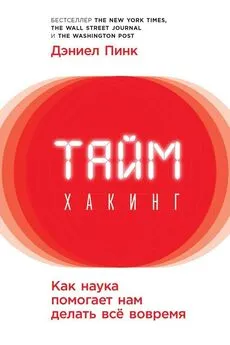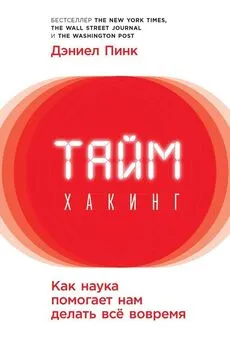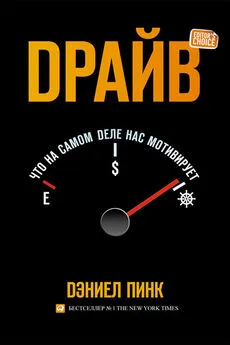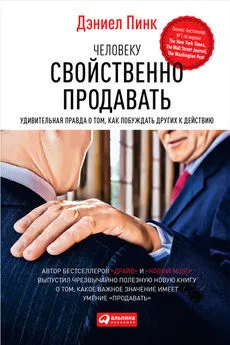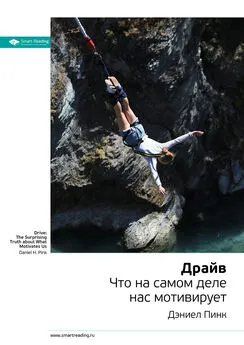Дэниель Пинк - Таймхакинг. Как наука помогает нам делать всё вовремя
- Название:Таймхакинг. Как наука помогает нам делать всё вовремя
- Автор:
- Жанр:
- Издательство:Литагент Альпина
- Год:2018
- Город:Москва
- ISBN:978-5-9614-1515-5
- Рейтинг:
- Избранное:Добавить в избранное
-
Отзывы:
-
Ваша оценка:
Дэниель Пинк - Таймхакинг. Как наука помогает нам делать всё вовремя краткое содержание
Таймхакинг. Как наука помогает нам делать всё вовремя - читать онлайн бесплатно ознакомительный отрывок
Интервал:
Закладка:
160
Sadie Stein, “I Always Start on 8 January,” Paris Review , January 8, 2013; Alison Beard, “Life’s Work: An Interview with Isabel Allende,” Harvard Business Review , May 2016.
161
Hengchen Dai, Katherine L. Milkman, and Jason Riis, “Put Your Imperfections Behind You: Temporal Landmarks Spur Goal Initiation When They Signal New Beginnings,” Psychological Science 26, no. 12 (2015): 1927–1936.
162
Jordi Brandts, Christina Rott, and Carles Sola, “Not Just Like Starting Over: Leadership and Revivification of Cooperation in Groups,” Experimental Economics 19, no. 4 (2016): 792–818.
163
Jason Riis, “Opportunities and Barriers for Smaller Portions in Food Service: Lessons from Marketing and Behavioral Economics,” International Journal of Obesity 38 (2014): S19–24.
164
John C. Norcross, Marci S. Mrykalo, and Matthew D. Blagys, “Auld Lang Syne: Success Predictors, Change Processes, and Self-Reported Outcomes of New Year’s Resolvers and Nonresolvers,” Journal of Clinical Psychology 58, no. 4 (2002): 397–405.
165
Lisa B. Kahn, “The Long-Term Labor Market Consequences of Graduating from College in a Bad Economy,” Labour Economics 17, no. 2 (2010): 303–316.
166
Эта идея лежит в основе теории хаоса и сложных систем. См., например: Dean Rickles, Penelope Hawe, and Alan Shiell, “A Simple Guide to Chaos and Complexity,” Journal of Epidemiology & Community Health 61, no. 11 (2007): 933–937.
167
Philip Oreopoulos, Till von Wachter, and Andrew Heisz, “The Short- and Long-Term Career Effects of Graduating in a Recession,” American Economic Journal: Applied Economics 4, no. 1 (2012): 1–29.
168
Antoinette Schoar and Luo Zuo, “Shaped by Booms and Busts: How the Economy Impacts CEO Careers and Management Styles,” Review of Financial Studies (forthcoming). (Электронные версии: https://ssrn.com/abstract=1955612или http://dx.doi.org/10.2139/ssrn.1955612.)
169
Paul Oyer, “The Making of an Investment Banker: Stock Market Shocks, Career Choice, and Lifetime Income,” Journal of Finance 63, no. 6 (2008): 2601–2628.
170
Joseph G. Altonji, Lisa B. Kahn, and Jamin D. Speer, “Cashier or Consultant? Entry Labor Market Conditions, Field of Study, and Career Success,” Journal of Labor Economics 34, no. S1 (2016): S361–401.
171
Jaison R. Abel, Richard Deitz, and Yaqin Su, “Are Recent College Graduates Finding Good Jobs?” Current Issues in Economics and Finance 20, no. 1 (2014).
172
Paul Beaudry and John DiNardo, “The Effect of Implicit Contracts on the Movement of Wages over the Business Cycle: Evidence from Micro Data,” Journal of Political Economy 99, no. 4 (1991): 665–688. См. также: Darren Grant, “The Effect of Implicit Contracts on the Movement of Wages over the Business Cycle: Evidence from the National Longitudinal Surveys,” ILR Review 56, no. 3 (2003): 393–408.
173
David P. Phillips and Gwendolyn E. C. Barker, “A July Spike in Fatal Medication Errors: A Possible Effect of New Medical Residents,” Journal of General Internal Medicine 25, no. 8 (2010): 774–779.
174
Michael J. Englesbe et al., “Seasonal Variation in Surgical Outcomes as Measured by the American College of Surgeons-National Surgical Quality Improvement Program (ACS-NSQIP),” Annals of Surgery 246, no. 3 (2007): 456–465.
175
David L. Olds et al., “Effect of Home Visiting by Nurses on Maternal and Child Mortality: Results of a 2-Decade Follow-up of a Randomized Clinical Trial,” JAMA Pediatrics 168, no. 9 (2014): 800–806; David L. Olds et al., “Effects of Home Visits by Paraprofessionals and by Nurses on Children: Follow-up of a Randomized Trial at Ages 6 and 9 Years,” JAMA Pediatrics 168, no. 2 (2014): 114–121; Sabrina Tavernise, “Visiting Nurses, Helping Mothers on the Margins,” New York Times, March 8, 2015.
176
David L. Olds, Lois Sadler, and Harriet Kitzman, “Programs for Parents of Infants and Toddlers: Recent Evidence from Randomized Trials,” Journal of Child Psychology and Psychiatry 48, no. 3–4 (2007): 355–391; William Thorland et al., “Status of Breastfeeding and Child Immunization Outcomes in Clients of the Nurse-Family Partnership,” Maternal and Child Health Journal 21, no. 3 (2017): 439–445; Nurse Family Partnership, “Trials and Outcomes” (2017). (Электронная версия: http://www.nursefamilypartnership.org/proven-results/published-research.)
177
Gary Klein, “Performing a Project Premortem,” Harvard Business Review 85, no. 9 (2007): 18–19.
178
Marc Meredith and Yuval Salant, “On the Causes and Consequences of Ballot Order Effects,” Political Behavior 35, no. 1 (2013): 175–197; Darren P. Grant, “The Ballot Order Effect Is Huge: Evidence from Texas,” May 9, 2016. (Электронная версия: https://ssrn.com/abstract=2777761.)
179
Shai Danziger, Jonathan Levav, and Liora Avnaim-Pesso, “Extraneous Factors in Judicial Decisions,” Proceedings of the National Academy of Sciences 108, no. 17 (2011): 6889–6892.
180
Antonia Mantonakis et al., “Order in Choice: Effects of Serial Position on Preferences,” Psychological Science 20, no. 11 (2009): 1309–1312.
181
Uri Simonsohn and Francesca Gino, “Daily Horizons: Evidence of Narrow Bracketing in Judgment from 10 Years of MBA Admissions Interviews,” Psychological Science 24, no. 2 (2013): 219–224.
182
Shai Danziger, Jonathan Levav, and Liora Avnaim-Pesso. “Extraneous Factors in Judicial Decisions,” Proceedings of the National Academy of Sciences 108, no. 17 (2011): 6889–6892.
183
Lionel Page and Katie Page, “Last Shall Be First: a Field Study of Biases in Sequential Performance Evaluation on the Idol Series,” Journal of Economic Behavior & Organization 73, no. 2 (2010): 186–198; Adam Galinsky and Maurice Schweitzer, Friend & Foe: When to Cooperate, When to Compete, and How to Succeed at Both (New York: Crown Business, 2015), 229.
184
Wändi Bruine de Bruin, “Save the Last Dance for Me: Unwanted Serial Position Effects in Jury Evaluations,” Acta Psychologica 118, no. 3 (2005): 245–260.
185
Steve Inskeep and Shankar Vedantan, “Deciphering Hidden Biases During Interviews,” National Public Radio’s Morning Edition , March 6, 2013, В интервью Саймонсон цит.: Uri Simonsohn and Francesca Gino, “Daily Horizons: Evidence of Narrow Bracketing in Judgment from 10 Years of MBA Admissions Interviews,” Psychological Science 24, no. 2 (2013): 219–224.
186
Michael Watkins, The First 90 Days: Critical Success Strategies for New Leaders at All Levels , read by Kevin T. Norris (Flushing, NY: Gildan Media LLC, 2013). Audiobook.
187
Ram Charan, Stephen Drotter, and James Noel, The Leadership Pipeline: How to Build the Leadership Powered Company, 2nd ed. (San Francisco: Jossey-Bass, 2011).
188
Harrison Wellford, “Preparing to Be President on Day One,” Public Administration Review 68, no. 4 (2008): 618–623.
189
Corinne Bendersky and Neha Parikh Shah, “The Downfall of Extraverts and the Rise of Neurotics: The Dynamic Process of Status Allocation in Task Groups,” Academy of Management Journal 56, no. 2 (2013): 387–406.
190
Brian J. Fogg, “A Behavior Model for Persuasive Design” in Proceedings of the 4th International Conference on Persuasive Technology (New York: ACM, 2009). Пояснения по мотивационным волнам см.: https://www.youtube.com/watch?v=fqUSjHjIEFg.
191
Karl E. Weick, “Small Wins: Redefining the Scale of Social Problems,” American Psychologist 39, no. 1 (1984): 40–49.
192
Teresa Amabile and Steven Kramer, The Progress Principle: Using Small Wins to Ignite Joy, Engagement, and Creativity at Work (Cambridge, MA: Harvard Business Review Press, 2011).
193
Nicholas Wolfinger, “Want to Avoid Divorce? Wait to Get Married, but Not Too Long,” Institute for Family Studies, July 16, 2015, which analyzed data from Casey E. Copen et al., “First Marriages in the United States: Data from the 2006–2010 National Survey of Family Growth,” National Health Statistics Reports , no. 49, March 22, 2012.
194
Scott Stanley et al., “Premarital Education, Marital Quality, and Marital Stability: Findings from a Large, Random Household Survey,” Journal of Family Psychology 20, no. 1 (2006): 117–126.
195
Andrew Francis-Tan and Hugo M. Mialon, “‘A Diamond Is Forever’ and Other Fairy Tales: The Relationship Between Wedding Expenses and Marriage Duration,” Economic Inquiry 53, no. 4 (2015): 1919–1930.
196
Elliot Jaques, “Death and the Mid-Life Crisis,” International Journal of Psycho- Analysis 46 (1965): 502–514.
197
Популярности этой теории в том числе поспособствовала и Гейл Шихи, автор бестселлера 1974 г. «Возрастные кризисы» [22] Шихи Г. Возрастные кризисы. – СПб.: Каскад, 2005.
, в котором описаны разные варианты кризиса середины жизни. Жак, правда, впервые упоминается там лишь на с. 369.
198
Elliot Jaques, “Death and the Mid-Life Crisis,” International Journal of Psycho-Analysis 46 (1965): 502–514.
199
Arthur A. Stone et al., “A Snapshot of the Age Distribution of Psychological Well-Being in the United States,” Proceedings of the National Academy of Sciences 107, no. 22 (2010): 9985–9990.
200
David G. Blanchflower and Andrew J. Oswald, “Is Well-Being U-Shaped over the Life Cycle?” Social Science & Medicine 66, no. 8 (2008): 1733–1749.
201
См. также: Terence Chai Cheng, Nattavudh Powdthavee, and Andrew J. Oswald, “Longitudinal Evidence for a Midlife Nadir in Human Well-Being: Results from Four Data Sets,” Economic Journal 127, no. 599 (2017): 126–142; Andrew Steptoe, Angus Deaton, and Arthur A. Stone, “Subjective Wellbeing, Health, and Ageing,” Lancet 385, no. 9968 (2015): 640–648; Paul Frijters and Tony Beatton, “The Mystery of the U-Shaped Relationship Between Happiness and Age,” Journal of Economic Behavior & Organization 82, no. 2–3 (2012): 525–542; Carol Graham, Happiness Around the World: The Paradox of Happy Peasants and Miserable Millionaires (Oxford: Oxford University Press, 2009).
Читать дальшеИнтервал:
Закладка:
